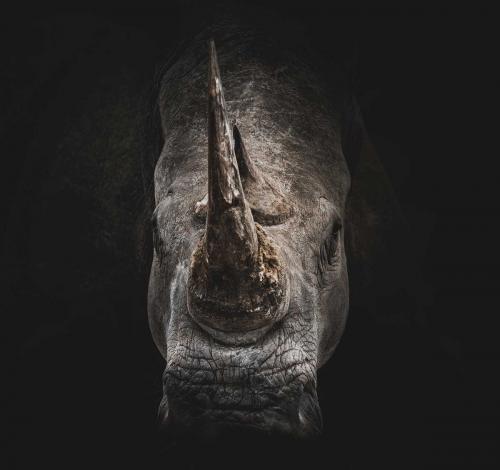I’ll remember the moment for the rest of my life … mostly in a cold sweat at 3 am. Me, standing unprotected, too far from the jeep for a run to safety, turning around to find a mother rhino just 25 metres away and facing my way.
That was back in late 2018, when I was fortunate to be on safari in Sabi Sands Game Reserve in South Africa, one of the best places on the continent to see wild rhino, whose numbers are dwindling. From more than half a million at the beginning of the 20th century, the World Wildlife Fund estimates that just 27 000 remain worldwide.
There are five surviving species of rhino: the black rhino and the white rhino in Africa; and the Javan, Sumatran and greater one-horned rhinos in Asia. All are threatened to some extent.
As for most threatened species, loss of habitat is a big factor in the decline of rhinos in the wild. But poaching also places enormous pressure on animals that are already too close to extinction. According to data from UK-based conservation charity Save the Rhino, numbers of African rhinos poached rose alarmingly from 60 in 2006 to 1346 in 2015, roughly where this story begins.
Desperate to stem the losses, wildlife NGOs and private enterprise began arguing about whether science can play a part in changing demand for exotic animal products – not just rhino horn, but lion bones, pangolin scales and elephant ivory.
Chemically speaking, there is nothing particularly special about rhino horn. It includes mainly calcium and melanin in a keratin matrix. In a manner similar to human hair and nails, it is produced by epidermal cells that undergo keratinisation and die.
Composition varies with the species and diet, but the northern white rhino horn contains 2% arginine, 5% lysine, 9% cholesterol, 3% taurine, 0.2–1% hexosamines (fructosamine and glucosamine) and 0.2% sphingosine in the keratin matrix, with significant inorganic content: 66–70% sulfur, 15–19% potassium, 5–9% calcium, 0–3% iron, 0.2–0.4% titanium and 0–4% zinc. The organics can typically vary ±20%, depending on diet.
A detailed 1993 study using scanning electron microscopy, X-ray diffraction and energy-dispersive X-ray spectroscopy found that the horn contains two separate phases: one of hair-like filaments, built around a central core of circumferential layers; and the other surrounding and filling in the spaces between the filaments as a matrix. Together, they form a ‘biological composite, structurally similar to metal, ceramic or polymer based composites’ (bit.ly/3uyXWS9).
The authors of that paper hypothesised that the production of synthetic rhino horn to flood the market ‘could reduce, or possibly eliminate poaching pressure on these animals’. It’s an interesting idea: if it were possible to produce a synthetic that is indistinguishable from the natural product, at a fraction of the cost of the illicit product, would this undercut and destroy the market for poachers?
Let’s start by looking at the markets for rhino horn. For the longest time, powdered rhino horn has been said to be linked to traditional Chinese medicine as an aphrodisiac. However, experts including Eric Dinerstein, WWF’s chief scientist for 25 years, said in an article by Jeremy Hsu for Scientific American that this is largely Western misunderstanding, and the evidence of usage in traditional Chinese medicine for aphrodisiac properties is weak (bit.ly/3dTaFJ0). According to Hsu, this appears to be backed up by surveys of end-users of the illicit product.
Instead, the markets for rhino horn appear to centre on three uses, primarily in Vietnam, and to some extent China. Although the Convention on International Trade in Endangered Species of Fauna and Flora has made international trade in rhino horn illegal since 1977, WWF says the demand is still high, so rhino poaching in both Africa and Asia continues to grow.
First, Hsu and others report evidence of a wealthy class of epicures who add the powdered horn to alcoholic beverages as a mark of status and exclusivity. People use the horn because it is expensive and rare, and as a mark of power in the disregard for the law. Few report any belief in aphrodisiac properties, although some do say they believe in hangover curative properties.
Second is the purchase and use of rhino horn by some Vietnamese women for the treatment of fever in their families. This is reported to be associated with traditional Chinese medicine, which may also be claiming the use of rhino horn for the treatment of cancer.
Third (and somewhat surprisingly, given their lack of visual appeal) is a substantial demand for artefacts made of rhino horn – cups, jewellery and other objets d’art.
So, while conservationists and regulators alike seek to disrupt supply of poached rhino horn (which is beyond the scope of this story), several companies have been established that seek to disrupt the markets for the illicit product.
Most prominent among these companies is Pembient Inc in the US. Pembient hoped to produce a synthetic rhino keratin base from sheep’s wool or from a recombinant protein secreted from genetically modified yeast (see box). To this can be added appropriate trace elements, amino acids, rhino DNA or rhino cells to achieve a chemical profile reflecting the natural product (bit.ly/3s0ily2). This material would then be 3D-printed, possibly onto a structural mould.
However, a large and vocal group of wildlife NGOs argue that these products made by Pembient – and the other companies seeking to synthesise animal products – will make the poaching problem significantly worse. They have the same laudable goal, but say that the scientists are dabbling in matters that they don’t properly understand.
‘It’s almost a knee jerk reaction, if you talk to most conservationists – they don’t like synthetics, end of story’, said economist Associate Professor Frederick Chen in a report published by Mongabay (bit.ly/3mx0bTw). Chen, based at Wake Forest University in North Carolina, focuses on the economics of conservation, and has modelled the introduction of synthetic products to the market: ‘… there is still a lot of detail and unknowns that need to be discussed and hammered out. The conversation in the community … has not been able to get to that point so far’.
On World Rhino Day in 2015, an international coalition of 10 wildlife NGOs published a joint statement calling on the US to ban research by several US companies into synthetic rhino horn (bit.ly/3mxSD2D). They argued that introducing synthetic rhino horn into an unpredictable market could have unintended and unpredictable consequences. It could remove the stigma associated with purchasing and using such products, which is known to act as a brake on demand.
Synthetic rhino horn could hamper law enforcement if it is so similar to the natural product that perpetrators can use ignorance as an excuse and if testing to identify the real thing is expensive or difficult. But even if identifying differences was feasible, or if DNA profiling was used to distinguish between existing types of natural horn, buyers are likely to still attempt to obtain poached rhino horn, say many wildlife NGOs.
It is also feared that people with scientifically unproven beliefs about rhino horn may view production of synthetic product as a sign that their beliefs are correct. This is particularly the case because a lot of traditional Chinese medicine treatments use several natural products. Identifying and selecting particular ingredients perceived to be active in the rhino horn mix can be difficult, and so demand for the real product would likely remain strong.
That same demand issue also applies to the wealthy beverage market. Surveys show that demand is not based on the properties of the product itself, but on its status as a rarity and its high price. It has been predicted by detractors that there would remain a strong or even increased demand (based on reduced stigma), and some surveys suggest that there will always be a segment of the market preferring wild product as long as it is available (bit.ly/329nIAB), regardless of the status of the species.
The disagreement isn’t helped by the fact that none of the companies proposing to develop synthetics is reported to be offering any funding for conservation efforts, and that this becomes tangled up with arguments about foreign companies profiting exclusively off the genetic diversity of poorer nations. Also, synthetic bear bile has existed for decades, and yet this has not decreased the market demand for this cruel product. Similarly, up to 90% of the material already illicitly traded as rhino horn is thought to be made from other horns, such as water buffalo, and this has not affected its price.
Faux leopard fur has been successfully taken up by the Shembe Church in southern Africa, considered to represent ‘the principal culture-religious use of illegal leopard skins in the world’ (doi.org/10.1111/csp2.289). However, it could be argued that as fur is not valued for its properties or how it is used, then it is a different market.
The economic modelling of the rhino horn market by Wake Forest University in 2017 concluded that the outcomes of synthetic horn production would be strongly dependent on market structure (doi.org/10.1016/j.ecolecon.2017.06.003). For example, if synthetic producers were to argue that their product was in some way superior to the natural version, they could place a premium on price and this could actually drive poaching up. But if competition in the market from multiple synthetic producers drove prices down, this might undercut poaching.
It was even argued that synthetic producers could deliberately produce inferior product to reduce market sentiment for the product as a whole – but it’s hard to think of any product anywhere where a company has deliberately taken that approach.
Ultimately, the university concluded ‘… the results here show how important it is that we have a clear understanding of the economics of synthetic horns if we care about the most effective way to save the rhinos’.
As a direct result of NGO pressures, Pembient walked back its plans after its launch in 2015. It gave up a planned collaboration in China to produce rhino horn beer, and it ceased marketing products such as rhino horn face cream. Other companies working on synthetic rhino horn in the US no longer exist.
This is an unusual situation. Every single party in the debate about synthetic rhino horn wants the same outcome. Everyone has their heart in the right place. They only differ in how to achieve protection of the species.





